Introduction
Candidates
Cost
Consultation
Question to Ask
Risks and Safety
Preparation
Procedure
Recovery
Results
Before and After Photos
Glossary of Terms
Choosing a Plastic Surgeon
Introduction
What is an Arm Lift?
An arm lift, or brachioplasty, is a surgical procedure that:- Reduces excess sagging skin that droops downward
- Tightens and smoothes the underlying supportive tissue that defines the shape of the upper arm
- Reduces localized pockets of fat in the upper arm region
Candidates
Who is a good candidate for arm lift surgery?
In general, arm lift candidates include:- Adults with significant upper arm skin laxity
- Adults of any age whose weight is relatively stable and who are not significantly overweight
- Healthy individuals without medical conditions that impair healing or increase risk of surgery
- Nonsmokers
- Individuals with a positive outlook and realistic expectations
Cost
How much does an arm lift cost?
The average cost of an arm lift is $4,482, according to 2018 statistics from the American Society of Plastic Surgeons. This average cost is only part of the total price – it does not include anesthesia, operating room facilities or other related expenses. Please consult with your plastic surgeon’s office to determine your final fee. A surgeon’s fee for arm lift surgery will be based on his or her experience, the type of procedure used and the geographic office location. Most health insurance plans do not cover arm lift surgery or its complications, but many plastic surgeons offer patient financing plans, so be sure to ask.Arm lift costs may include:
- Anesthesia fees
- Hospital or surgical facility costs
- Medical tests
- Post-surgery garments
- Prescriptions for medication
- Surgeon’s fee
Consultation
What should I expect during a consultation for arm lift surgery?
During your arm lift surgery consultation be prepared to discuss:- Your surgical goals
- Medical conditions, drug allergies and medical treatments
- Current medications, vitamins, herbal supplements, alcohol, tobacco and drug use
- Previous surgeries
- Evaluate your general health status and any pre-existing health conditions or risk factors
- Take photographs
- Discuss your options
- Discuss likely outcomes of arm lift surgery and any risks or potential complications
Question to Ask
What questions should I ask my plastic surgeon about arm lift surgery?
Use this checklist as a guide during your arm lift surgery consultation:- Are you certified by the American Board of Plastic Surgery?
- Were you specifically trained in the field of plastic surgery?
- How many years of plastic surgery training have you had?
- Do you have hospital privileges to perform this procedure? If so, at which hospitals?
- Is the office-based surgical facility accredited by a nationally- or state-recognized accrediting agency, or is it state-licensed or Medicare-certified?
- Am I a good candidate for this procedure?
- What will be expected of me to get the best results?
- Where and how will you perform my procedure?
- What surgical technique is recommended for me?
- How long of a recovery period can I expect, and what kind of help will I need during my recovery?
- What are the risks and complications associated with my procedure?
- How are complications handled?
- How can I expect my arms to look over time?
- What are my options if I am dissatisfied with the cosmetic outcome of my arm lift?
- Do you have before-and-after photos I can look at for this procedure and what results are reasonable for me?
Risks and Safety
What are the risks of arm lift surgery?
The decision to have plastic surgery is extremely personal, and you’ll have to decide if the benefits, risks and potential complications of arm lift surgery are acceptable. You will be asked to sign consent forms to ensure that you fully understand the procedure. Arm lift surgery risks include:- Anesthesia risks
- Bleeding
- Infection
- Poor wound healing
- Unsightly scarring
- Fluid accumulation (seroma)
- Damage to deeper structures such as nerves, blood vessels and muscles
- Fatty tissue under the skin might die (fat necrosis)
- Numbness or other changes in skin sensation
- Pain, which may persist
- Sutures may not absorb, but spontaneously surface through the skin, causing irritation, drainage and redness
- Possible need for revisional surgery
Preparation
How should I prepare for arm lift surgery?
In preparing for arm lift surgery, you may be asked to:- Get lab testing or a medical evaluation
- Take certain medications or adjust your current medications
- Stop smoking
- Avoid taking aspirin, anti-inflammatory drugs and herbal supplements as they can increase bleeding
Procedure
What are the steps of an arm lift procedure?
An arm lift procedure includes the following steps:Step 1 – Anesthesia
Medications are administered for your comfort during arm lift surgery. The choices include intravenous sedation and general anesthesia. Your doctor will recommend the best choice for you.Step 2 – The incision
Incision length and pattern during arm lift surgery depend on the amount and location of excess skin to be removed, as well as the best judgment of your plastic surgeon. Incisions are generally placed on the inside of the arm or on the back of the arm, depending on the surgeon’s preference, and may extend from the underarm (axilla) to just above the elbow. Excess fat may be directly excised or treated with liposuction. Depending on your specific condition, incisions may be more limited. Then, underlying supportive tissue is tightened and reshaped with internal sutures. Finally, the skin is smoothed over the new contour of your arm.Inner arm incision
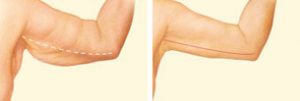
Back of arm incision

Minimal incision

Step 3 – Closing the incisions
Your incisions will be closed either with absorbable sutures or stitches that will be removed within one to two weeks following your arm lift.Step 4 – See the results
The smoother, tighter contours that result from brachioplasty are apparent almost immediately following your procedure, although there will likely be swelling and bruising. Get more information about arm lift surgery results.Recovery
What should I expect during my arm lift recovery?
During your recovery from arm lift surgery, dressings or bandages may be applied to your incisions, and your arms may be wrapped in an elastic bandage or a compression garment to minimize swelling following surgery. A small, thin tube may be temporarily placed under the skin to drain any excess blood or fluid. You will be given specific instructions on how to care for the surgical site and drains, medications to apply or take orally to aid healing, specific concerns to look for and when to follow up with your plastic surgeon. Be sure to ask your arm lift surgeon specific questions about what you can expect during your individual recovery period:- Where will I be taken after my surgery is complete?
- What medication will I be given or prescribed after surgery?
- Will I have dressings/bandages after surgery? When will they be removed?
- Are stitches removed? When?
- When can I resume normal activity and exercise?
- When do I return for follow-up care?
Results
What results should I expect after arm lift surgery?
The smoother, tighter contours that result from arm lift surgery are apparent almost immediately following your procedure. Initial results will be obscured by swelling and bruising, and a scar will remain where the incision was made. Although good results are expected from your procedure, there is no guarantee. In some situations, it may not be possible to achieve optimal results with a single surgical procedure and another surgery may be necessary. The results of arm lift surgery will be long-lasting, provided that you maintain a stable weight and general fitness. As your body ages, it is natural to lose some firmness, but most of your improvement should be relatively permanent. Following your physician’s instructions is essential to the success of your surgery. It’s important that the surgical incisions are not subjected to excessive force, swelling, abrasion or motion during the time of healing. Your doctor will give you specific instructions on how to care for yourself.Before and After Photos
Arm Lift Before & After Photos
View before and after photos of arm lift procedures performed by members of the American Society of Plastic Surgeons. |
 |
 |
 |
 |
 |
 |
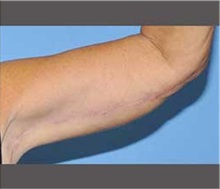 |
 |
 |
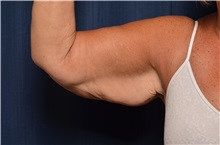 |
 |
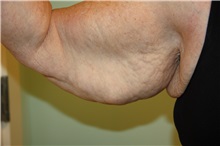 |
 |
 |
 |
 |
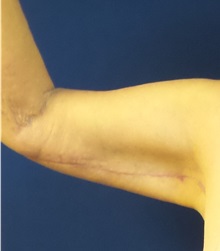 |
 |
 |
Glossary of Terms
What words should I know about arm lift surgery?
Arm lift
A surgical procedure, also known as brachioplasty, to correct sagging of the upper arms.Axilla
The underarm area.Brachioplasty
A surgical procedure, also known as arm lift, to correct sagging of upper arms.General anesthesia
Drugs and/or gases used during an operation to relieve pain and alter consciousness.Hematoma
Blood pooling beneath the skin.Intravenous sedation
Sedatives administered by injection into a vein to help you relax.Liposuction
Also called lipoplasty or suction lipectomy, this procedure vacuums out fat from beneath the skin’s surface to reduce fullness.Local anesthesia
A drug injected directly to the site of an incision during an operation to relieve pain.Skin laxity
Degree of loose skin.Sutures
Stitches used by surgeons to hold skin and tissue together.Choosing a Plastic Surgeon
How do I choose a plastic surgeon for arm lift surgery?
Arm lift surgery involves many choices. The first and most important is selecting a board-certified plastic surgeon you can trust who is a member of the American Society of Plastic Surgeons (ASPS). ASPS member surgeons meet rigorous standards:- Board certification by the American Board of Plastic Surgery® (ABPS) or in Canada by the Royal College of Physicians and Surgeons of Canada®
- Complete at least six years of surgical training following medical school with a minimum of three years of plastic surgery residency training
- Pass comprehensive oral and written exams
- Graduate from an accredited medical school
- Complete continuing medical education, including patient safety, each year
- Perform surgery in accredited, state-licensed, or Medicare-certified surgical facilities
